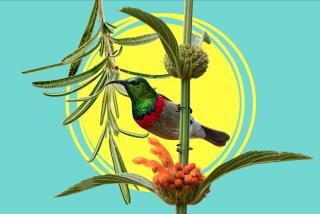New Flower Around Town : For the First Time, Gesneriads--Relatives of the African Violet--Are Available in Southern California
THESE ARE ALL RELATIVES of the common African violet, members of the Gesneriad family. Their names are all tongue twisters, such as Aeschynan (try “ees-kin-ANTH-us”) or Koellikeria (you’re on your own here), but they are not as difficult to grow as they are to pronounce, and they are guaranteed to rekindle a flagging interest in indoor plants.
Most gesneriads are from the tropics of Central and South America, though some are native to Africa, Indochina, Borneo, New Guinea and other steamy places, so the one thing they need is humidity--but not the suffocating kind; a tray of water underneath will do. All gesneriads are easily undone by too much water and should not be watered until nearly dry. They don’t need heat--they don’t even like it--and many can stand enough the cold to be grown outdoors in the coastal areas. Many do extremely well under fluorescent lights, provided that the lights are not far away (4 to 12 inches is recommended).
At one time gesneriads were very hard to find and could only be seen as drawings in catalogues. Now, however, the nursery with the largest collection of the various gesneriads has moved from the East Coast to California. Kartuz Greenhouse, in Vista, is not a big operation, but the plants are available there--although there might be a wait. Seeing the collection in person is most impressive; remember, though, that in general gesneriads are very small plants.
One way to get a handle on all the mysterious-sounding names is to put them into categories according to their care requirements. The first group would include gesneriads that go dormant, or nearly so, in winter. They grow from scaly rhizomes (tuber-like affairs that sustain them even when they are leafless). Included are the tubular-flowered Achimenes ; the true Gloxinia , which is not the kind that florists sell; Kohleria , with incredibly bright flowers (some are spotted), and Smithiantha . The latter’s common name, temple bells, describes the shape and the color of its bright flowers.
To care for gesneriads that go dormant, stop watering them in the fall or when they begin to fade. Keep them almost dry all winter. Begin watering again in March or April; then keep the soil barely moist until growth appears.
Another grouping would be the trailing types that should be planted in hanging containers. They are perfect for bright windows (and will even take a little direct sunlight). The pots needn’t be too large, because the root systems are not. Aeschynanthus (better known as the lipstick plant), Codonanthe (with waxy flowers and berries to boot), Columnea (which the Kartuz catalogue describes as having “flame-like flowers”), the many Episcia , the easy-to-grow Nematanthus (which needs less warmth and humidity) and the equally easy Streptocarpella are all spectacular cascading out of pots. Some of these will grow outdoors; Streptocarpella is an unbelievable ball of blue when grown outdoors in a hanging basket. Judge for yourself at Sherman Library and Gardens in Corona del Mar, where one walk is lined with them.
Young trailing gesneriads should have their ends pinched off regularly to encourage branching. As they get lanky or leafless with age, cut them back, or start new ones from cuttings. (All gesneriads are easy to grow from cuttings if they are given a little humidity.) The next category is composed of the small and sometimes downright tiny gesneriads. The miniature Sinningia can grow in a thimble. Gesneria have the brightest of flowers (perhaps so they won’t go unnoticed because of their size). And there are the miniature African violets ( Saintpaulia ) that will charm the socks off even the most hardened plantsman. All of these are especially suited for terrariums.
And finally, there are the gesneriads that can be grown outdoors, at least along the coast (inland, they should come indoors for the winter so they don’t freeze): the giant florist’s gloxinia ( Sinningia ) and the very pretty and tough Cape primrose ( Streptocarpus ) . These need more light than what’s usually available indoors, but not direct sunlight. A perfect place for the Cape primrose, for instance, is with ferns and begonias in a shady part of the garden. Other gesneriads can grow outdoors, so be sure to ask the nursery when purchasing one. Beware that the florist’s gloxinia may go dormant in winter and must be kept dry, out of the rain, until spring.
Most gesneriads will thrive in a potting mix that you can make yourself: two parts peat moss (don’t get an inexpensive, powdery brand), two parts perlite and one part vermiculite. Or use a good African violet mix. Pots needn’t be very large. Fertilizing may actually harm the plants, so do so infrequently, if at all.






